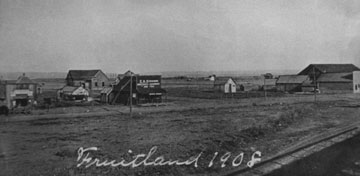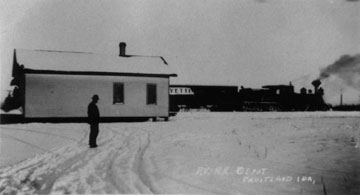 Fruitland's history began with John Hall's homestead of 160 acres in 1897. Half was sold to Anthony and Amelia Zeller and soon the crossroads were dubbed "Zeller's Crossing."
Fruitland's history began with John Hall's homestead of 160 acres in 1897. Half was sold to Anthony and Amelia Zeller and soon the crossroads were dubbed "Zeller's Crossing." During the 1930s depression, hundreds of migrant workers set up their cardboard and scrap lumber shacks on an end of Peterson's Orchards. They were looking for work on area farms and orchards. It was called "Hooverville" after US President Herbert Hoover. He had promised in the elections "that prosperity was just around the corner." Thousands of people lost their homes and jobs with the stock market crash of October 1929. Banks failed and people's savings were lost. The midwest dust storms added to the westward migration.
During the 1930s depression, hundreds of migrant workers set up their cardboard and scrap lumber shacks on an end of Peterson's Orchards. They were looking for work on area farms and orchards. It was called "Hooverville" after US President Herbert Hoover. He had promised in the elections "that prosperity was just around the corner." Thousands of people lost their homes and jobs with the stock market crash of October 1929. Banks failed and people's savings were lost. The midwest dust storms added to the westward migration. In 1900, Mrs. Sherman and infant child died. His sister came from Iowa to care for his children and home for two years. In 1902, Sherman married a Payette widow, Eva Josephine Phillips. This was also the year his dream of building a castle was realized. David H. Snowberger was hired to cast cement blocks assisted by H. J. Tharp. Water was hauled up the bluff from the Snake River in barrels until a pump was put in place. A well was dug nearby more than a hundred feet deep. During the digging, a workman was killed. Electricity was never installed in the structure. The first tower was completed and the family moved in while construction continued on the rest of the building.
In 1900, Mrs. Sherman and infant child died. His sister came from Iowa to care for his children and home for two years. In 1902, Sherman married a Payette widow, Eva Josephine Phillips. This was also the year his dream of building a castle was realized. David H. Snowberger was hired to cast cement blocks assisted by H. J. Tharp. Water was hauled up the bluff from the Snake River in barrels until a pump was put in place. A well was dug nearby more than a hundred feet deep. During the digging, a workman was killed. Electricity was never installed in the structure. The first tower was completed and the family moved in while construction continued on the rest of the building.| Read More Articles by Ron Marlow | Learn More about Mr. Marlow |